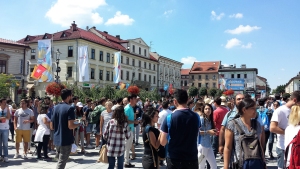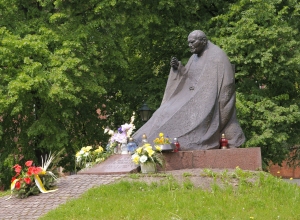At first glance, it’s an unassuming dessert. Two layers of puff pastry, a soft cream filling, a dusting of powdered sugar. Known locally as kremówka, it has taken on a second name for many: Papieszka Kremówka, or “the Pope’s cream cake.” What began as a simple confection in a small-town bakery has, over time, come to symbolize a thread of cultural continuity in modern Poland.
Its appeal lies not only in its composition but in its backstory—an anecdote that links a national sweet to one of Poland’s most prominent 20th-century figures.
Origins in Wadowice
Wadowice, nestled in the foothills of southern Poland, was in the 1930s a quiet town marked by baroque architecture and local shops. Among these was a patisserie run by the Austrian Hagenhuber family. It was here that Karol Wojtyła, a local secondary school student who would later become Pope John Paul II, developed a fondness for the kremówka.
Following exams, Wojtyła and his classmates would gather at the same table to celebrate with slices of the pastry. It was a small ritual—ordering their favorite dessert, sharing conversation, enjoying a moment of pause. At the time, no one could have anticipated that this adolescent habit would, decades later, evolve into a symbol with national resonance.

An Offhand Remark Becomes Legend
The dessert’s transformation into cultural artifact began in June 1999. On an official visit to his hometown, the Pope addressed a crowd in Wadowice’s central square. Speaking with affection, he recounted familiar places from his youth—churches, school corridors, and the streets he walked as a boy. Then he added, with characteristic humor:
“After our final exams, we used to go eat kremówki. One time I ate eighteen. They didn’t make me sick. And no, they didn’t have alcohol, as some people thought!”
The comment sparked laughter and immediate media coverage. The next day, headlines across Poland replayed the story. From that moment, the Papieszka Kremówka was born—its popularity fueled by a mix of nostalgia, humor, and public affection.
From Local Pastry to National Icon
Within weeks, patisseries across Poland were renaming their kremówki in honor of the Pope. Some reimagined it with added liqueur, fruit, or chocolate. Others remained faithful to its original simplicity: crisp pastry, light cream, sugar on top.
In Wadowice, tourist interest surged. Beyond visiting the Pope’s birthplace or the basilica where he was baptized, many began seeking out the kremówka itself. It became more than a sweet treat—it was a piece of living history, integral to local identity and cultural tourism.
A Dessert of Many Forms
Despite its symbolic status, Papieszka Kremówka resists codification. Its recipe varies by region and baker. Some versions are filled with vanilla custard and whipped cream, others with a denser diplomatic cream. Flavors may be enhanced with rum or citrus zest; some serve it chilled to highlight the texture of the filling.
Mastering it involves technical precision. The pastry must be delicate yet sturdy, the cream soft but structured. This balance has earned the kremówka a place in the repertoire of both seasoned pastry chefs and home bakers.
Among all its variations, the most cherished remains the one tied to the memory of the young Karol—at that table, surrounded by friends and laughter.

A Familiar Symbol
Over the years, Papieszka Kremówka has come to embody a sense of shared heritage. Its significance extends beyond religious affiliation. For many, it represents a glimpse into the Pope’s youth—a moment of humanity, before the title. It recalls a teenager with ordinary routines, a sweet tooth, and a capacity for joy.
The dessert’s reach has expanded into schools, where it features in culinary workshops; into homes, where it’s made to commemorate the Pope’s memory; and into storytelling, as grandparents pass on anecdotes to new generations.
In 2019, a formal proposal was submitted to recognize the Papieszka Kremówka as intangible cultural heritage in Poland—not for its culinary merit alone, but for the social role it has come to play.
The Digital Afterlife
Each May, during the anniversary of John Paul II’s birth, interest in the dessert resurfaces online. Google searches for terms like “Pope’s cake,” “Wadowice dessert,” and “Papieszka Kremówka” spike. YouTube and blogs offer home recipes, step-by-step tutorials, and historical explainers. On Instagram, the hashtag #kremówka tags hundreds of photos. TikTok challenges echo the Pope’s joke: can you eat eighteen?
This online presence has helped carry the kremówka into the digital age, reinforcing its relevance for younger audiences.
Where Memory Meets Flavor
The story of Papieszka Kremówka illustrates how ordinary gestures can acquire lasting cultural weight. It is not rooted in ceremony or doctrine, but in something simpler: a slice of cake, a fond memory, a shared laugh.
This familiarity—the gesture of eating, remembering, and retelling—anchors the dessert in everyday life. It is through such moments that collective identity often finds expression: not in grand statements, but in small, consistent rituals.
In Wadowice today, the kremówka is still made and shared. Some seek it out for nostalgia, others for tradition, still others for the pleasure of pastry. But each slice carries a subtle imprint of history—a trace of youth, a hint of the everyday, and a story that still resonates.
No need for eighteen slices to understand it. One is enough.





